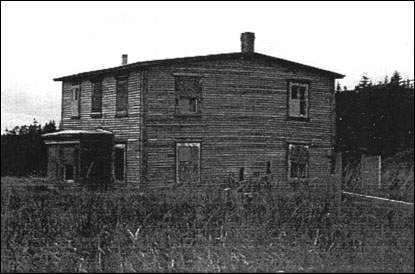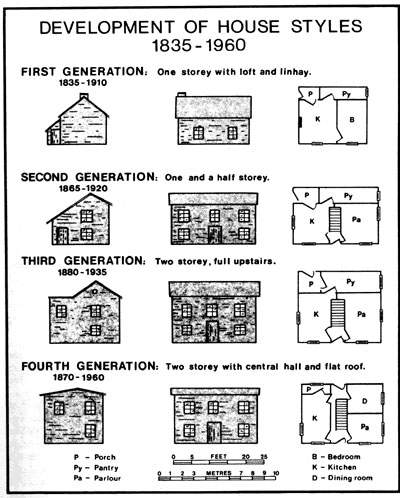Newfoundland Folk Architecture
by Andrew Woodland
The unique and striking architecture of Newfoundland
has served to draw many tourists to the province. The Heritage
Foundation of Newfoundland and Labrador has long recognized and been an
advocate of architectural heritage as an important factor in the
preservation of Newfoundland's cultural identity . The preservation of
individual structures is crucial to the tourist industry, and the
economic well being of communities.
Architectural heritage is not only of value to
economic growth, it also contributes to social survival. If the value of
what our ancestors built and the documentation of the skills used in
constructing these buildings are recognized, then Newfoundland heritage
in our Canadian society will be further enhanced.
Preserving our Past
Many people are drawn towards our beautiful old
buildings and we, as Newfoundlanders, feel a strong pride that goes
along with the wood and nails. The preservation of Newfoundland folk
architecture in recent years has received deserving attention. In
Bonavista, for example, the community college has developed a heritage
carpentry course. Students learn how to reconstruct heritage houses, and
as a result they are also enriched with the art of making traditional
furniture. In Trinity, a number of local carpenters have revived the
making of traditional windows and have created a market for these
products throughout the province. Also, an inventory of Newfoundland
folk homes is being compiled as part of a strategy to preserve
Newfoundland's architectural heritage.
Location, Location, Location!
Due to the lifestyles of early Newfoundlanders, many
of their houses were built upon hillsides and cliffs by the sea. This
would allow for easy access to the water for fishing. This posed a
problem for the fishermen since building on a steep incline was risky
business. The houses were unstable and in heavy rains, very
unpredictable. In 1973, a mud slide caused by heavy rains swept four
houses built along a hillside into the harbour. Four children died that
night. This is a dark side of Newfoundland folk architecture; our houses
are subject to harsh environmental conditions.
|
|
First Generation House
Sometimes referred to as a settlers house, these homes
were built most frequently from 1835-1910. These houses were very rugged
looking one story dwellings and were made from rudimentary materials.

Figure 1
Second Generation House
Better known as a salt box, these homes were built most
frequently from 1865-1920. The house pictured below was basically a
settlers house but was built with higher quality materials. This house,
however, had one and a half storeys.

Figure 2
Third Generation House
This house is also known as a salt box (modified). It was
built most frequently between1880-1935. This house had two full storeys
and was slightly larger than the salt box.

Figure 3
Fourth Generation House
This house, the largest of the folk houses, has two full
storeys, a central half hall, and a flat roof. This house, known as a
biscuit box was built most frequently between 1870-1960.

Figure 4
This classification system helps researchers document
existing folk homes. This is illustrated in the table below entitled
"Development of House Styles 1835-1960" which was taken from The
Peopling of Newfoundland and Labrador.

Figure 5
(Figures 1, 2 & 5)
Reproduced by permission of David Mills. From John J. Mannion, ed., The
Peopling of Newfoundland: essays in historical geography, Social and
Economic Papers series; No. 8 (St. John's, Newfoundland: Institute of
Social and Economic Research, Memorial University of Newfoundland, ©1977)
84, 89, 86.
(Figures 3 & 4)
Reproduced by permission of the Heritage Foundation of Newfoundland and
Labrador, St. John's, Newfoundland. From Dale Jarvis, ed., Heritage
Inventory of the Bonavista Peninsula: preliminary Inventory report of
selected pre-1920 structures in the Bonavista Peninsula area, vol. 1
(St. John's, Newfoundland: Heritage Foundation of Newfoundland and
Labrador, ©1995) 303, 122. |